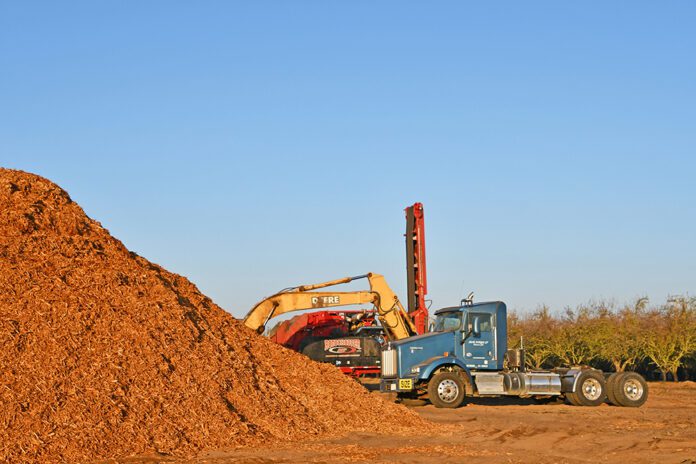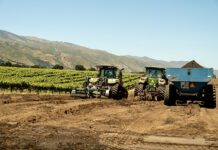So you’ve pulled out your old orchard, now what? Many tree nut producers are asking themselves that same question as walnut and to a lesser extent almond prices remain low, input costs continue to climb, interest rates are still elevated and water reliability is questionable.
While some producers have replanted former orchards with the same crop or another permanent crop after ground preparation, others have taken a more wait-and-see approach. Among options that offer more farming flexibility are fallowing, which still requires work to minimize weed and pest issues, or putting the ground into row crops. And some growers have decided to get out of farming altogether.
For a number of row crops, UC has developed the rice rotation calculator that lets growers gauge how different rotations will affect their profitability. But the university does not have a similar decision-support tool for permanent crops, said Brittney Goodrich, former UC Davis Extension ag economist who now works for University of Illinois, Urbana-Champaign Extension.
“Such a tool would be very useful, so it’s unfortunate that one doesn’t exist,” she said. In lieu, Goodrich pointed to UC Davis’ cost and returns studies for hypothetical orchards using different production systems. The analyses are only meant as guides and don’t represent any single farm.
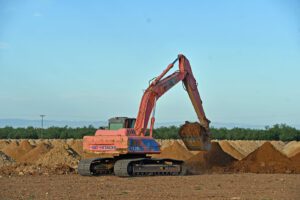
‘Brings Tears to My Eyes’
Bob Beede, UCCE farm advisor emeritus in Kings County, has watched the struggles of area walnut producers in recent years. Describing the small-scale growers comprising much of Kings County’s acreage as “mom and pop operations,” he said many have poured their life savings into their orchards only to lose money in recent years.
They typically are not vertically integrated with businesses, such as driers that could potentially offset some losses, nor do they have other crops that could possibly shore them up financially.
“In all of my 45 years as a resident of the county of Kings and having spent 38 as a UC farm advisor serving the tree fruit and nut industries in Kings County, I can unequivocally say I’ve never seen it as decimated as I have in the last three or so seasons,” Beede said. “It brings tears to my eyes to see all my ag friends and farmer friends struggling after working their entire lives to build up enough wealth so they could pass on a successful farming operation to children who are interested in farming. The mom and pops have now sold property, equipment, maybe dipped into their 401k programs to cover some of their losses in hopes the market will turn around.”
Driving around, Beede said it’s common to see a wasteland of dead trees that used to be thriving orchards. Rather than continuing to pour money into their blocks, many producers have just quit farming them.
While some may plan to have them pulled and chipped, others can’t afford the service. Less apparent is the huge mental stress the financial struggles are causing producers, he said.
Beede pointed to the COVID-19 pandemic as one of the main drivers behind the walnut industry’s current economic malaise. Until 2020, many south San Joaquin Valley producers grew the Serr walnut variety, which was harvested early and could make it into lucrative holiday export markets.
But with port shutdowns, shipping container shortages and other supply chain issues, Serr producers lost the market primarily to Chilean producers and never gained it back. Supply backups domestically were repeated throughout the walnut industry, and prices frequently plummeted to below the cost of production. A 2022 summer heat wave that damaged about a third of the walnut crop only added to the industry’s economic woes.
Walnut prices have finally begun to inch back up and are starting to return to profitable levels for some producers. Adding uncertainty is the south San Joaquin Valley’s water outlook.
This year, the federal Central Valley Project (CVP) only delivered 50% of contracted amounts for South of Delta agricultural contractors. The Bureau of Reclamation, which operates the CVP, didn’t even announce the final allocation until June 24, further complicating planning.
Much of the delivery reductions stem from the 1992 Central Valley Project Improvement Act, which diverted up to 800,000 acre-feet of water annually from agriculture to environmental uses. In response, many growers turned to groundwater.
But the Sustainable Groundwater Management Act of 2014 requires overdrafted and severely overdrafted groundwater basins to balance extraction with recharge by 2042 or 2040, respectively. Already, the state has tried to take over groundwater management in a handful of groundwater subbasins because it said local agencies have not done enough to reduce land subsidence caused by overpumping.
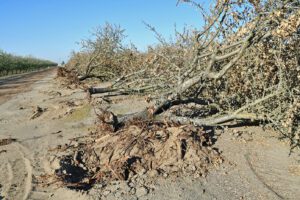
NASS Numbers Tell the Story
Faced with growing uncertainty, Beede said, numerous producers have decided to get out of walnuts.
Those decisions were borne out in the USDA National Agricultural Statistics Service’s 2023 California Walnut Acreage Report released May 23. Walnut bearing acreage was on a steady climb in the state, peaking with 400,000 acres in 2022 before dropping to an estimated 385,000 acres in 2023 and 370,000 bearing acres this season.
Ken Vogel, who farms walnuts and cherries with his son near Linden, is another walnut producer who cut his losses. He is removing an older Hartley orchard, taking care not to damage the irrigation system that serves an adjacent cherry orchard.
In its place, he plans to plant coral champagnes, an early maturity cherry variety.
“For the last several years, corals have done pretty well,” Vogel said. “I’d thought about leasing it out for melons, but I think I’d have to pay to get the whole orchard cleaned up. This is kind of the least expensive way to do it.”
On his other small ranch that has later-maturing Bing cherries, he plans to graft over to corals. Not only do Bings do poorly in the heat, but the later variety frequently competes with Washington cherries as they enter the market. The only walnuts Vogel plans to keep are about 12 acres of the Chandler variety, which is what many marketers prefer.
Vogel said he feels fortunate because he also has a house and mobile home on one ranch that he rents out. “It’s a better source of income than the walnuts,” he said.
He hoped the orchard modifications and rental income will allow him to stay in business without selling any property, since one ranch has been homesteaded since 1864.
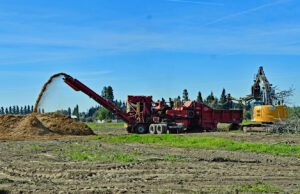
Almond Trends Spur Optimism
Almond producers also faced post-COVID-19 market challenges caused by backed up exports, which resulted in larger supplies, less demand and lower prices. About 70% of the state’s almonds are shipped to other countries.
The price decline prompted many almond producers to evaluate their blocks and remove less productive ones. Since 2019, the Almond Board of California has contracted with Land iQ, a Sacramento-based agricultural consulting firm, to provide almond acreage figures. The company bases its estimates on remote sensing, artificial intelligence, ground truthing and other verification methods.
Total almond acreage dropped to 1.56 million acres in 2023 from 1.64 million in 2022, according to Land iQ. Bearing acres, those planted in 2020 or earlier, increased slightly to 1.37 million acres in 2023 from 1.34 million acres the previous year. But the amount of non-bearing acres (new orchards planted in 2021, 2022 or 2023) decreased by about 105,000 acres to 189,000 acres in 2023.
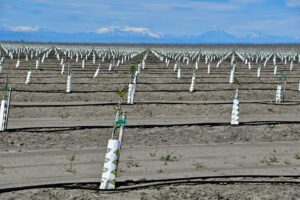
Orchard removals also continue to rise, with about 83,000 acres being removed as of Aug. 31, 2023, compared to 60,400 acres in 2022.
The reduced almond acreage coupled with a lower-than-expected USDA objective crop estimate in July pushed almond prices slightly higher. Based on the market trends, Escalon-area almond producer Herman Doornenbal Jr. said he is more optimistic.
He purchased a block of nearby ground last year that was in cereal hay. After harvest, he deep plowed it, and the ground is currently fallow.
“I’m starting to warm to the idea of putting it into trees,” he said. “The prices are trending a little bit up, but it’s what I do, I’m an almond farmer.”
Originally, Doornenbal said, he had planned to put it into alfalfa, but hay prices have grown worse.
“The guys who are taking their orchards out, a lot of them used to be row crop farmers or grow field crops, so I think a lot of them are going back to it. They’re worried about the price of almonds. They’re worried about the big investment to get into it.
“I’m convinced that the price of alfalfa is going to get worse. There’s a lot of hay being grown.”
Doornenbal said he’s excited about the ground’s potential because it has never been in tree crops. That means he likely won’t have to deal with prunus replant disease, which may occur when stone fruit or almond orchards are planted in succession without proper fumigation.

Vicky Boyd | Contributing Writer
A veteran agricultural journalist, Vicky Boyd has covered the industry in California, Florida, Texas, Colorado, the South and the Mid-South. Along the way, she has won several writing awards. Boyd attended Colorado State University, where she earned a technical journalism degree with minors in agriculture and natural resources. Boyd is known for taking complex technical or scientific material and translating it so readers can use it on their farms. Her favorite topics are entomology, weeds and new technology. When she’s not out “playing in the dirt,” as she calls agricultural reporting, Boyd enjoys running, hiking, knitting and sewing.







